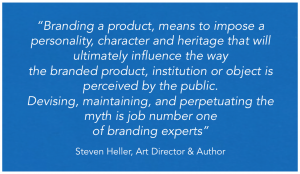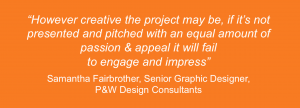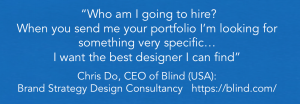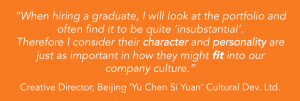Why should you consider a portfolio an important part of your creative personal promotional campaign?

A portfolio is a voyage of self-discovery, it's confidence building, showcasing your work and an opportunity to celebrate, promote and perhaps even brag - a little.
Your portfolio and self-promotion sets you apart from other creative applicants. It’s a multi-platform marketing device, presenting & pitching you, your creative and technical abilities to the professional world. Without it think how difficult it will be to sell of your ideas, demonstrate your key skills, developing knowledge and experience?
Here you can express your personality and skills, providing proof to prospective employers of your potential to be that perfect fit to for that dream job you are aiming for.

Think how this relates to your personal brand and promotion.
We can learn from the strategies and techniques advertising and marketing people use to sell products and services to us and look to promote ourselves in a similar way.
Character - your values, passions and beliefs
Personality - your identity and USP (unique selling point)
Heritage - your skills & experience
These are important aspects of you to communicate to your target audience who will want to learn as much about the person who's created the work as well as the creative work itself.
1) Visibility & Choosing The Right Platforms
When you start designing and populating your portfolio you also need to work out what platform(s) it’s best suited to be viewed on. It can be challenging to decide, as there are many of options online.
- Sites generic to all professions offer simple quick solutions but with limited scope to create your own brand: WordPress, Squarespace, Wix, and Tilda
- More bespoke sites, suitable for creatives & designers such as Behance, Dribble etc.
- Ultimately you can design your own site and build it yourself - or get it built for you and you have control over the look & feel and market your identity and USP, into a standout calling card.
- For interviews and promotion, create a specific edited selection that’s tailored to that specific company and or individual.
- Multiple versions demonstrate astute self-marketing skills and a wider reach of appeal.
2) Ensuring The Essential Part Of You Is Promoted
Make sure it's all there - in the portfolio. Create the right balance of the following essential ingredients:
- Accentuate and include your strengths, interests, passions, values and experiences.
- Emphasis what stands out - that’s unique & special.
- Showcase your skills, versatility, influences and processes.
- Demonstrate what value can you offer that no other applicant can.
- 'Design' your portfolio - by creating your brand - then carefully compose and insert each and every project with care.
- Discover your USP (Unique Selling Point) and build it into a dynamic portfolio of work to sell.

7. Add your logo motif and tagline that explains what you do.

8. Ensure the portfolio format/brand design compliments and displays the work effectively.
9. Think whether relying on a generic template and ‘white space’ will make your portfolio of work stand out from the competition? Does it demonstrate passion for your craft; that you care about the presentation as much as the work itself? Every aspect of a portfolio communicates a visual design statement, from the composition you construct, the typography you select, the colour scheme..
10. But keep in mind - whilst being creative with the format, your portfolio needs to draw attention to the quality of the individual work. So striking a balance is essential not to distract from it by being over-complicated in the platform design.
3) Promoting Specialist & Generalist Skills
Multi-Potentialites
Within the Creative Industries, there are many crossover skills that create what we might call ‘multi-potentialites’. This has various meanings, but in the context of creative careers, it signifies “somebody who has potential in multiple fields.”
If you progress through a series of job roles (sometimes referred to as a portfolio career), you’ll inevitably gain multiple skills, some specialised and some generalist, enabling you to broaden your fields of expertise and career opportunities.
Any role in the creative industries (and elsewhere) will have a balance of these specialist and generalist skills. Generalist skills could be seen as more transferable, such as graphic design principles and techniques. Whereas learning specific software programmes may be highly specialised and unique to a particular job role.
You may be focusing on a particular area such as: Print Design, Motion Design, UX/UI Design, VFX & 3D, Illustration, Editing, or perhaps Videography… whilst they have various generalist skills in common, all these roles require specialist creative and technical skills and your portfolio of work needs to demonstrate this in the various projects you include.


As you explore & develop interests in particular skills and areas of design… consider how your work can be presented and communicated to demonstrate your developing specialisms to maximise your uniqueness and align with areas of job role and its particular requirements.

4) Identifying Your Audience
Create a profile of a company’s site and its job roles you’re interested in and see how you fit. Take time to plan and align your portfolio and 360º marketing campaign accordingly.
When doing your company & job role searches and identifying your particular area of interest - ask yourself the question:
Would I like to work like them one day?
If so, the next question is:
How am I going to get there?
Through self-promotion, your personality, your brand identity and your portfolio.
The content and structure will vary according to the audience, which dictates the choice of platform and its format. So prepare and design according to what they want to see. Use different platforms to advertise and position yourself with short intros, relevant content and the right tone of voice to make you an irresistible match.
5) The Key Things You Want Your Audience To Learn?
It’s not only about the pictures… Whilst the visual content is the core stimulus and main selling point, it's what you say about the work, describing how you arrive at your ideas and production process that gives further meaning, context and value; creating a conversational narrative.

6) The Strategic 'About Me' Page
 Your “About Me” page is the most-visited page on your online portfolio website. Once they have checked-out some of your work, they'll then want to know about you.
Your “About Me” page is the most-visited page on your online portfolio website. Once they have checked-out some of your work, they'll then want to know about you.
It's your chance to show your personality, passion, drive and knowledge. However, don't assume your audience will figure out and understand who you are and what your about, just by looking at the project work... so you need to provide that claim ownership of your identity and its promotion.
This vital element of the portfolio could be seen as a type of CV introduction that providing a more conversational tone and personal snapshot of your professional background, relevant skills, and key accomplishments that appeal to recruiters and creative employers.
You want to make sure visitors and readers to your site understand your work, but you don’t want to go into too much detail - it's not an essay.
Ultimately the purpose of your portfolio as a promotional device and everything in it shows prospective clients and employers why they will benefit from hiring you over someone else who offers the same services as you do. Employers love to see candidates who are genuinely excited about the work you've done and want to do do in the future.
Companies want to invest in people who are interested in sticking around for the long-term.
Passionate employees are more likely to make significant contributions to the work being done by the company and go on to manage or train other employees, rather than leaving after a year.
Facts and data about you and your skills can make potential clients or employers interested in you, your story and personal experiences seal the deal. For example, you can share your likes, dislikes, and any interests that are relevant to your field. This allows them to understand that you’re also human and encourage connection even before you meet them personally.
Testimonials - We are all used to looking at those customer product reviews.. so why not include external endorsements about you? But ensure it's relevant to the career you've fixed your sights on, from genuine and mutually agreed sources to impress and inform. keep it short and focused on the key skill or behaviour you want endorsed.
Your Contact Information - Make it clear and easy for them to get hold of you.
7) Retention is a very real challenge for many employers - looking at rewarding and beneficial ways to keep people is as much their responsibility, as for employees to perform and contribute to the business. This is a two-way process a contract your future employer and you sign up to.
a curious mind and great ideas; the passion to inspire & inform, present & communicate, with originality, self confidence, adaptability, understanding and a love of working with people
Why not use this insight into what creative industry employers are looking for - it might help as a guide to how you can use some of these traits (distinguishing qualities or characteristics), to describe and sell your creative personality and identity as you create your portfolio. Ticking a few key boxes…
8) Recruitment Gatekeepers
The Creatives
It’s a fact - professional creatives (not just the senior ones), are information rich and time poor with limited attention spans.
However, they know exactly what they are looking for and recognise talent when they see it
So when networking and contacting those creatives you’ve selected through careful research, be sure the emphasis is on the ‘seeing’… so as visual communicators your marketing strategy and material needs to appeal to like-minded, visually focused people.
Matching their creative work culture
Understanding their artistic direction
Using their visual & verbal language
Finding out about their personality where you can
The Recruiters & HR Teams
But keep in mind if you’re applying for a position, the recruitment process may involve multiple gatekeepers. Most likely non-visually aware individuals in Recruitment or HR departments will process your application before reaching the desired creatives.
They will be more focused matching your soft skills to the job specifications and will most likely have written the example behaviours below:
- Eagerness to learn about our products & services to effectively contribute to our brand
- A keen eye for detail with excellent organisational skills
- Effective communication and interpersonal skills
- Highly developed sense of integrity and commitment to customer satisfaction
So when crafting your creative content and 'About Me' section - be guided by what these two groups involved in the recruitment process need to see and hear; ensuring your connecting, providing for and speaking to all interested parties.
Conclusions
So in order to create a clear understanding of how to promote who you are and what skills you have - make sure you keep the following guidelines in mind when constructing and self-promoting you and your portfolio:
- Who are you selling yourself to?
- Know your audience & speak their language
- Make it conversational using a narrative construct for maximum appeal
- Create bespoke categories for projects
- Position your work for maximum value
- Edit work down to key content and show the processes
- The 'About Me' section is vital - adding your personal insight and context
- Where appropriate create multi-purpose portfolios to suit specific job expectations
Action: Before constructing your portfolio, identify who your selling it to. What you want them to see in you and the work. Make a list of potential creative jobs and companies that you like and might match.
Start researching their USP, their clients and specialist skills they look for in their employees. Then start creating a promotional campaign that includes that all important professional portfolio to match.
All photographs in this blog are courtesy of: Unsplash - https://unsplash.com/
© Paul Butler is a Creative Careers Adviser, Design Director and HE Lecturer in employability and Creative Industry careers.
For one-to-one creative careers advice and coaching contact me at: paulb@creativecareersadvice.com
If you found this blog useful share it with your contacts and follow me for more posts on creative careers advice and employability topics.
Related articles: Confidence In Public Speaking / Pitch & Presentation / How To Build Effective Client Relationships & Cope with Feedback / Becoming A Great Public Speaker
Why not sign up for membership of Tern Heads: https://ternheads.com/
A creative community of peers and professionals, dedicated to entry-level talent. We offer a network of accessible opportunities and a space to showcase your work to potential employers.
